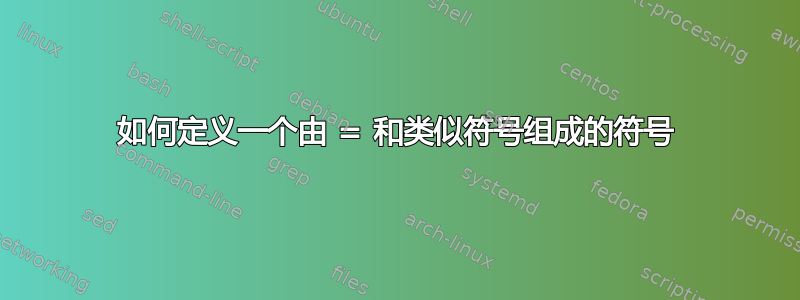
答案1
只需用第一个符号创建一个命令,然后\hspace{-1em}再用下一个符号创建一个命令:
\documentclass{article}
\newcommand\smequal{<\hspace{-1em}=}
\begin{document}
$a \smequal b$.
\end{document}
在您编辑以指定它不应该之后<,您也可以使用 tikz:
\documentclass[10pt,a4paper]{article}
\newcommand\smequal{\ \tikz{\draw (0.5em,0.5em) to[out=-180,in=70] (0,.25em) to[out=-70,in=-180] (0.5em, 0);}\hspace{-1em}=}
\usepackage{tikz}
\begin{document}
$a \smequal b$.
\end{document}
由于您没有指定“类似于<”应该是什么样子,因此您需要调整参数直到您满意为止......
编辑:
当然也可以删除符号周围的空格:
\documentclass[10pt,a4paper]{article}
\newcommand\smequal{\tikz{\draw (0.5em,0.5em) to[out=-180,in=70] (0,.25em) to[out=-70,in=-180] (0.5em, 0);}\hspace{-1em}=\hspace{-0.3em}}
\usepackage{tikz}
\begin{document}
$a \smequal b$.
\end{document}
对我来说这太紧了......但当然你也可以调整参数来满足你的空白需求。
答案2
我不熟悉这个符号,但它似乎确实与字体有关。您可以使用\ooalign叠加已旋转 90 度(需要)的=符号\smallfrown(使用) 。使用该符号将调整为脚本和脚本脚本样式。amssymbgraphicx\mathpalette
\documentclass{article}
\usepackage{amssymb, graphicx}
\makeatletter
\newcommand{\oldimplies}{\mathrel{\mathpalette\old@implies\relax}}
\newcommand{\old@implies}[2]{%
\ooalign{%
$\m@th#1=$\cr
\hidewidth$\m@th#1\rotatebox[origin=c]{90}{$\m@th#1\smallfrown$}$\hidewidth\cr
}%
}
\makeatother
\begin{document}
$A\oldimplies B_{A\oldimplies B_{A\oldimplies B}}$
\end{document}
例如,如果您想将皱眉稍微向右移动,您可以添加一些水平空间4mu(实际上只会移动,2mu因为它以皱眉为中心)。
\hidewidth$\m@th#1\mkern4mu\rotatebox[origin=c]{90}{$\m@th#1\smallfrown$}$\hidewidth\cr
答案3
这与或\isinE中的⋹ 非常相似。但是,那里的删除线符号是子集。stixunicode-math
答案4
在@egreg的帮助下(见解决方案在这里),我给出了两种解法。显然第一种更接近于施罗德的解法,也符合我的口味。有些文章或书籍也使用与第二种类似但不如第二种美观的符号。第一种和第二种都可以。你可以选择任意一种。
1. 将 的一部分\circ、 的一部分<和合并=。
\documentclass{article}
\usepackage{amsmath,amsfonts,amssymb,graphicx}
\usepackage{trimclip}
\makeatletter
\newif\if@schroder
\newcommand{\roundless}{\mathrel{\@schroderfalse\mathpalette\round@less\relax}}
\newcommand{\round@less}[2]{%
\clipbox{0pt 0pt {0.755\width} 0pt}{\raisebox{0.145ex}{\scalebox{1}[0.745]{$\m@th#1\circ$}}}%
\clipbox{{0.38\noexpand\width} 0pt 0pt 0pt}{$\m@th#1<$}%
\if@schroder\settowidth{\dimen@}{$\m@th#1<$}\kern-0.05\dimen@\fi
}
\newcommand{\schroderimply}{\mathrel{\mathpalette\schroder@imply\relax}}%%Shroder imply
\newcommand{\schroder@imply}[2]{%
\vphantom{<}%
\ooalign{\hidewidth$\@schrodertrue\round@less{#1}{}$\cr$\m@th#1=$\cr}%
}
\newcommand{\schroderconimply}{\mathrel{\reflectbox{\ensuremath\schroderimply}}}%%Shroder converse imply
\makeatother
\begin{document}
\huge
\[\phi\schroderimply \psi\schroderconimply \theta\]
\end{document}
\subset2. 将和的一部分合并=。该解决方案也或多或少地受益于上述@Davislor 的解决方案。
\documentclass{article}
\usepackage{amsmath,amsfonts,amssymb,graphicx}
\usepackage{trimclip}
\makeatletter
\newif\if@schroder
\newcommand{\varsubset}{\mathrel{\@schroderfalse\mathpalette\var@subset\relax}}
\newcommand{\var@subset}[2]{%
\clipbox{0pt 0pt {0.525\width} 0pt}{$\m@th#1\subset$}%
\clipbox{{0.725\noexpand\width} 0pt 0pt 0pt}{$\m@th#1\subset$}%
\if@schroder\settowidth{\dimen@}{$\m@th#1\subset$}\kern-0.05\dimen@\fi
}
\newcommand{\schroderimply}{\mathrel{\mathpalette\schroder@imply\relax}}%Shroder imply
\newcommand{\schroder@imply}[2]{%
\vphantom{\subset}%
\ooalign{\hidewidth$\@schrodertrue\var@subset{#1}{}$\cr$\m@th#1=$\cr}%
}
\newcommand{\schroderconimply}{\mathrel{\reflectbox{\ensuremath\schroderimply}}}%Shroder converse imply
\makeatother
\begin{document}
\huge
\[\phi\schroderimply \psi\schroderconimply \theta\]
\end{document}










